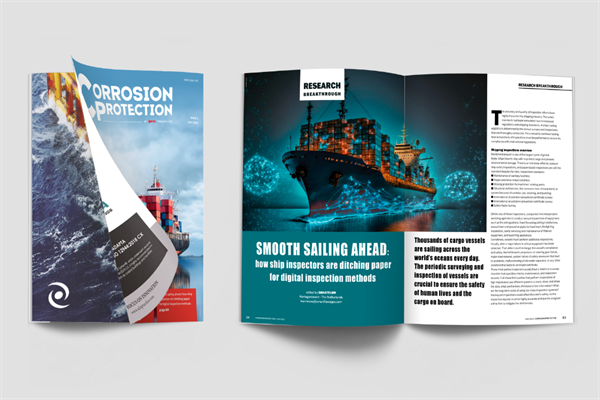
Read the latest issue of the magazine dedicated to corrosion prediction, prevention, protection and mitigation. Special edition on the marine industry!
While corrosion is certainly an issue for all metal structures installed on land, it is however 1,000 times so in the marine sector, especially for splash zones, i.e., areas in direct contact with the flow of sea or river water and therefore subject to splashes and wave motion – such as the pillars of offshore platforms, wind turbines and sea cranes or the pylons of bridges and harbours.
Parts, tools and structures located in water are the most difficult to protect with a view to long term integrity because they are subjected to the cross attack of water, humidity, sun and mechanical actions – all the corrosion triggering agents gathered in a single environment.
The marine habitat is in itself a multiplying factor of corrosion onset rapidity, propagation rate and severity on seafront structures due to its salinity and moisture load, but for all assets that are immersed in water or subject to splashing water, erosion, abrasion, structural and biofouling issues also arise.
Corrosion protection of splash zones is therefore one of the most difficult tasks for designers, applicators, and maintainers alike. Yes, because the owners of assets characterised by splash zones have a responsibility to ensure their maintenance, since their failure entails enormous financial damage and often also considerable environmental damage.
Severe conditions are faced when applying protection/repairing products during such maintenance operations, so much so that many available solutions are ruled out because they cannot be applied underwater, in very humid conditions or in the open sea.
Moreover, in addition to technical and performance requirements and the compatibility of products with the marine environment, their low environmental impact aspect constitutes an important prerequisite for the success of the protection technologies employed, not only in terms of the absence of VOCs but also of the release of pollutants (such as heavy metals) into the water.
It is easy to see how the field of corrosion protection for offshore structures and the naval sector (where biofouling and cavitation issues are also to be faced) is one of the most fertile for technological research and development.
This is the reason why we have chosen to devote almost the entirety of this Corrosion Protection issue to the topic of corrosion in the marine sector, including splash zones, dry docks, shipyards and offshore structures.
On the following pages, you will find a series of scientific studies from prestigious University institutes as well as industrial and application case studies and technical interviews on a wide range of solutions that successfully address many of the challenges posed by corrosion mitigation in marine environments. Effective solutions to increase asset service life and reduce downtime are simply no longer enough. They must also be environmentally friendly, resource efficient and beneficial for improving the operability of the assets themselves in the long term.
READ THE MAGAZINE!